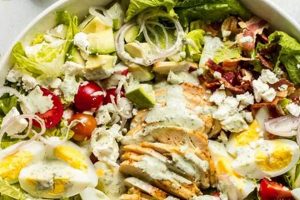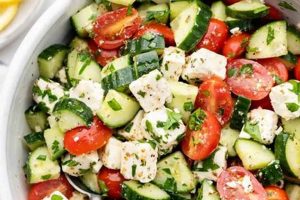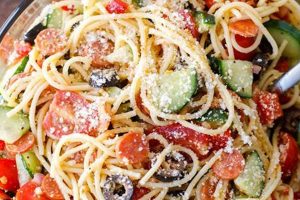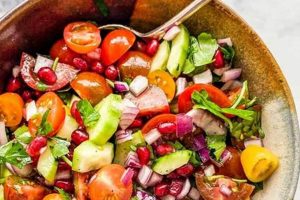Dishes centered on uncooked, shredded or grated carrots, combined with various other fresh ingredients and dressings, offer a simple, nutritious, and refreshing culinary experience. These preparations typically incorporate a blend of textures and flavors, achieved through the addition of components such as nuts, seeds, fruits, herbs, and contrasting vegetables. A vinaigrette, creamy dressing, or a simple lemon-juice based dressing often completes the dish.
Such culinary creations provide a significant source of vitamins, minerals, and fiber, particularly vitamin A and beta-carotene. The inherent sweetness of carrots allows for minimal added sugar, aligning with healthier dietary choices. Historically, consuming raw vegetables has been a widespread practice across cultures, predating modern cooking methods. This tradition underscores the inherent nutritional value and accessibility of fresh produce.
This exploration will delve into diverse approaches to these preparations, ranging from classic combinations to innovative flavor profiles. Nutritional aspects, ingredient selection, preparation techniques, and creative presentation suggestions will be discussed.
Tips for Carrot Salad Preparation
Optimizing flavor and texture requires attention to detail throughout the preparation process. The following tips provide guidance for creating successful dishes.
Tip 1: Grate or shred carrots uniformly. Consistent size ensures even coating with dressing and contributes to a pleasant mouthfeel. A food processor or box grater facilitates this process.
Tip 2: Select fresh, firm carrots. Peak-season carrots offer the best flavor and sweetness. Avoid carrots that appear limp, dry, or have cracks.
Tip 3: Balance flavors effectively. Combine sweet, acidic, salty, and savory elements for a well-rounded taste profile. Consider incorporating citrus zest, nuts, dried fruits, or fresh herbs.
Tip 4: Dress salads just before serving. This prevents the carrots from becoming soggy and maintains the crispness of other added ingredients.
Tip 5: Explore diverse textures. Toasted nuts, seeds, or dried fruits offer textural contrast to the softer carrots. Consider adding thinly sliced or shredded vegetables like cabbage or radish.
Tip 6: Utilize a sharp knife for chopping ingredients. Clean cuts maintain the visual appeal of the salad and prevent bruising delicate herbs.
Tip 7: Experiment with different dressings. A simple vinaigrette, a creamy dressing, or a citrus-based dressing can complement the natural sweetness of carrots.
Adhering to these guidelines ensures a delightful culinary experience with optimal flavor, texture, and visual appeal. These preparations offer versatile options for a light meal, side dish, or potluck contribution.
By understanding the nuances of ingredient selection, preparation techniques, and flavor balancing, culinary enthusiasts can create exceptional carrot salads.
1. Fresh, High-Quality Carrots
The foundation of any successful raw carrot salad rests upon the selection of fresh, high-quality carrots. These provide optimal flavor, texture, and nutritional value, significantly influencing the overall dish. Subpar carrots can detract from the sensory experience, impacting both taste and enjoyment.
- Flavor and Sweetness
Freshly harvested carrots possess a natural sweetness and vibrant flavor absent in older, stored produce. This inherent sweetness allows for less reliance on added sugars in dressings, aligning with healthier eating habits. Flavor intensity directly correlates with freshness, contributing to a more satisfying culinary experience.
- Texture and Crispness
Optimum texture is crucial in raw preparations. Fresh carrots offer a desirable crispness that contrasts pleasantly with other ingredients. Limp or rubbery carrots, indicative of age or improper storage, compromise the textural integrity of the salad.
- Nutritional Value
Nutrient content, particularly vitamins and antioxidants, diminishes over time. Freshly harvested carrots maximize the nutritional benefits associated with raw consumption. This factor is a key consideration for health-conscious individuals seeking to maximize nutrient intake.
- Visual Appeal
Vibrant color and unblemished surfaces contribute to an aesthetically pleasing salad. Fresh carrots possess a bright, appealing color that enhances the overall presentation of the dish. Visual appeal plays a significant role in enjoyment and perceived freshness.
The selection of high-quality carrots directly influences the overall success of raw carrot salads. Prioritizing freshness ensures optimal flavor, texture, nutritional value, and visual appeal, creating a more enjoyable and healthful culinary experience. Discerning palates will appreciate the noticeable difference between salads prepared with fresh, vibrant carrots and those made with less optimal produce.
2. Variety of Textures
Textural diversity significantly elevates raw carrot salad recipes from simple to complex culinary experiences. A combination of textures enhances sensory enjoyment and provides a more satisfying mouthfeel. The interplay between crisp, crunchy, chewy, and smooth elements creates a dynamic eating experience that surpasses the limitations of a single texture.
Consider the foundational element: grated or shredded carrots. While providing a pleasant base texture, relying solely on this element can result in a monotonous experience. Introducing contrasting textures adds depth and complexity. Toasted nuts, such as walnuts or pecans, contribute a satisfying crunch. Seeds, like sunflower or pumpkin, offer a delicate crispness. Dried fruits, such as cranberries or raisins, introduce a chewy element. These additions create a multi-faceted textural profile that stimulates the palate and elevates perceived flavor complexity.
Furthermore, textural variety can extend beyond these common additions. Incorporating shredded coconut adds a delicate chewiness and subtle sweetness. Thinly sliced red onion provides a sharp, crisp counterpoint. Even the choice of dressing contributes to textural interplay. A light vinaigrette offers a smooth, contrasting element, while a creamy dressing, perhaps based on yogurt or tahini, introduces a rich, coating texture. The careful consideration of these elements transforms a simple salad into a dynamic and engaging culinary creation. Understanding the importance of textural variety allows for more creative and satisfying raw carrot salad recipes.
3. Balanced Flavor Profiles
Balanced flavor profiles are essential for successful raw carrot salad recipes. The inherent sweetness of carrots necessitates the incorporation of other taste elements to prevent a one-dimensional culinary experience. Balancing sweetness with acidity, saltiness, bitterness, and umami creates a complex and harmonious flavor profile that elevates the dish beyond its basic components. This balance prevents any single flavor from dominating, allowing for a nuanced and enjoyable experience.
Acidity, often introduced through citrus juice or vinegar, cuts through the sweetness of the carrots, providing a refreshing counterpoint. Salt enhances the natural flavors and balances the acidity. Bitterness, which can be introduced through ingredients like radicchio or arugula, adds depth and complexity. Umami, found in ingredients like toasted nuts or crumbled cheese, provides a savory richness that rounds out the flavor profile. A classic example of this balance is a carrot salad with lemon juice (acidity), a pinch of salt, chopped walnuts (umami), and golden raisins (sweetness). The interplay of these flavors creates a more satisfying and complex experience compared to a salad solely composed of grated carrots.
Understanding the interplay of these taste elements allows for greater culinary creativity and control. Recipes can be tailored to individual preferences, emphasizing specific flavor profiles or dietary restrictions. The purposeful inclusion of contrasting flavors transforms a simple carrot salad into a sophisticated dish. Failure to achieve flavor balance often results in a less satisfying culinary experience, highlighting the importance of this principle in raw carrot salad preparations.
4. Complementary Dressings
Complementary dressings are integral to successful raw carrot salad recipes. Dressings provide not only moisture and flavor but also contribute to the overall balance and textural complexity of the dish. The inherent sweetness of carrots necessitates careful dressing selection to avoid an overly sweet or one-dimensional flavor profile. A well-chosen dressing enhances the carrots’ natural sweetness while introducing complementary flavor notes, such as acidity, tanginess, or savory richness. Furthermore, the dressing’s texture plays a crucial role, offering a contrasting element to the crispness of the raw carrots. A light vinaigrette, for instance, provides a smooth counterpoint, while a creamy dressing adds a rich, coating element.
Several factors influence dressing selection. Flavor compatibility is paramount. A citrus vinaigrette, with its bright acidity, effectively balances the carrot’s sweetness. A ginger-soy dressing introduces umami and savory notes. A creamy dressing based on tahini or yogurt adds richness and a contrasting texture. The intensity of the dressing should also be considered. Delicate flavors benefit from lighter dressings, allowing the natural sweetness of the carrots to shine. Bolder flavors can withstand more robust dressings. For example, a carrot salad with cilantro, jalapeo, and lime benefits from a vibrant lime-cilantro vinaigrette. Dietary restrictions, such as vegan or gluten-free preferences, also influence dressing choices. Numerous readily available or easily prepared options cater to these specific needs.
Understanding the role of complementary dressings is crucial for elevating raw carrot salad recipes from simple to exceptional. Careful consideration of flavor profiles, textures, and dietary considerations ensures a well-balanced and enjoyable culinary experience. The dressing acts as a unifying element, bringing together the various ingredients and creating a harmonious final product. The absence of a complementary dressing often results in a less satisfying dish, underscoring the importance of this often-overlooked component.
5. Creative Presentation
Creative presentation elevates raw carrot salad recipes from simple dishes to visually appealing culinary creations. While flavor and texture remain paramount, visual appeal significantly influences perceived enjoyment and perceived quality. Thoughtful presentation enhances the dining experience, transforming a basic salad into an enticing and memorable dish. This aspect becomes particularly important when serving guests or aiming for a restaurant-quality presentation at home. The impact of visual appeal should not be underestimated; it directly influences how the dish is received and perceived.
Several techniques contribute to creative presentation. Consider moving beyond simply placing the salad in a bowl. Using a mandoline to create thin carrot ribbons adds an element of elegance. Arranging the salad components on individual plates offers a more formal approach. Incorporating height and contrasting colors creates visual interest. For instance, a mound of grated carrots topped with vibrant green herbs and a sprinkle of toasted nuts or seeds presents a more appealing image than a uniformly mixed salad. Utilizing various serving vessels, such as small glasses or hollowed-out vegetables, adds an element of surprise and sophistication. Garnishes play a critical role. A simple sprig of parsley or a sprinkle of paprika can significantly enhance the visual appeal without dominating the flavor profile. Even the choice of serving utensils influences presentation; using attractive tongs or serving spoons adds a touch of refinement.
The practical significance of creative presentation extends beyond mere aesthetics. It communicates care and attention to detail, elevating the perceived value of the dish. This element is particularly relevant in professional settings, such as restaurants or catering events, where visual presentation significantly influences customer satisfaction. However, the principles of creative presentation are equally applicable in home kitchens. Elevating everyday meals through thoughtful presentation enhances the dining experience, making even simple dishes more enjoyable. The effort invested in presentation demonstrates respect for the ingredients and the dining experience, transforming a basic carrot salad into a culinary statement.
Frequently Asked Questions
This section addresses common inquiries regarding raw carrot salad recipes, providing clear and concise information to assist culinary endeavors.
Question 1: How long can raw carrot salad be stored?
Refrigeration in an airtight container extends shelf life for up to three days. However, optimal texture and flavor are best enjoyed within 24 hours of preparation. Beyond this timeframe, some softening and potential flavor degradation may occur.
Question 2: Can alternative vegetables be incorporated into raw carrot salads?
Absolutely. Ingredients such as shredded beets, zucchini, or bell peppers enhance both flavor and nutritional value. Experimentation with various vegetables allows for diverse flavor profiles and personalized culinary creations.
Question 3: What are suitable alternatives to nuts and seeds for those with allergies?
Sunflower seeds, pumpkin seeds, or chopped dried fruit offer textural variety and flavor complexity in the absence of nuts. Roasted chickpeas or edamame provide alternative protein sources.
Question 4: Are there specific carrot varieties best suited for raw salads?
While most varieties are suitable, Imperator, Nantes, and Chantenay carrots generally offer excellent sweetness and texture for raw preparations. These varieties provide optimal flavor and maintain desirable crispness in salads.
Question 5: How can enzymatic browning in raw carrot salad be prevented?
Immersing shredded or grated carrots in a solution of water and a small amount of lemon juice helps inhibit enzymatic browning, preserving color and visual appeal. This simple technique maintains the vibrant orange hue of the carrots.
Question 6: Can raw carrot salads contribute to a healthy diet?
Rich in vitamins, minerals, and fiber, these salads offer significant nutritional benefits. Carrots provide substantial amounts of beta-carotene and vitamin A, essential for optimal health. Furthermore, the inclusion of other fresh vegetables and a balanced dressing enhances the overall nutritional value.
Understanding these key aspects enables informed decision-making regarding ingredient selection, preparation methods, and storage techniques. This knowledge base empowers culinary exploration and ensures successful outcomes in creating healthy and flavorful raw carrot salads.
The next section will explore specific recipe variations and offer detailed preparation instructions.
Conclusion
Raw carrot salad recipes offer a versatile and nutritious culinary canvas. Exploration of ingredient selection, textural variety, flavor balancing, complementary dressings, and creative presentation reveals the potential of this seemingly simple dish. Emphasis on fresh, high-quality carrots ensures optimal flavor and nutritional value. Understanding the interplay of textures, from the crispness of raw carrots to the crunch of nuts and seeds, elevates sensory enjoyment. Balancing sweetness with acidity, saltiness, and other flavor notes creates a harmonious and complex taste profile. Complementary dressings further enhance the overall experience, adding moisture, flavor, and textural contrast. Finally, thoughtful presentation transforms the dish into a visually appealing culinary creation.
Culinary exploration of raw carrot salad recipes extends beyond basic nutrition. The versatility of these preparations allows for creative expression and personalized flavor combinations. From simple, everyday meals to elegant presentations for special occasions, raw carrot salads offer a refreshing and healthful option. Continued experimentation with ingredients and techniques promises further culinary discoveries and an ever-evolving appreciation for the potential of this versatile dish. The possibilities are limited only by culinary imagination.






